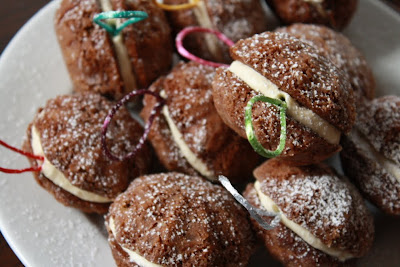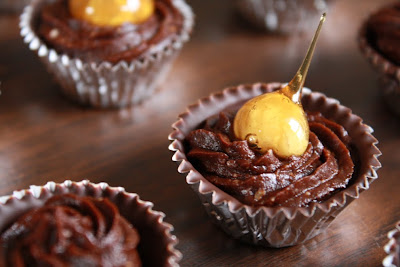Here I go again with the oranges and chocolate. It's a good combo, what can I say? I was drawn to this torte in particular because the entire orange is used: peel, seeds and all. Cool, no?
This recipe is for a 9-inch torte, but my new cake stand won't accommodate a cake that big (and I prefer smaller cakes anyway) so I used two smallish blood oranges and halved all the other ingredients. I should have poured all the batter (or most of it) into one 6-inch pan, but, having divided it between two pans, saved the cake (I hope) by going double decker. Then there's the issue of the almonds. I should have blanched and ground my own almonds, but I was lazy and bought almond meal so what should be a lovely cake the color of sunshine is marred by the unwelcome presence of skins. But nevermind.
Orange Torte
adapted from Aaron Maree
- 3 oranges
- 6 eggs, separated
- 180 g sugar
- 1 tsp. baking powder
- 280 g ground almonds
- blank
- 250 g apricot jam
- 60 ml water
- 2 tsp. lemon juice
- blank
- 1/2 recipe basic ganache
- Place oranges in a pot, cover with water, and boil them for an hour and a half. While still hot, place oranges in a blender or food processor and blend to a pulp. Set aside.
- Preheat oven to 350°F. Grease a 9-inch cake pan (or a combination of smaller pans) and line the bottom(s) with parchment. Set aside.
- In a stand mixer fitted with the whisk attachment, beat egg yolks and half the sugar until yolks are pale and have reached the ribbon stage. Transfer to another bowl and set aside.
- Wash your bowl and whisk attachment, then beat egg whites to stiff peaks, adding the remaining sugar in spoonfuls just before it reaches this stage. Add the ground almonds and baking powder and beat until well combined.
- Fold yolk mixture into the orange pulp, then fold in the egg white mixture. Pour batter into prepared pan and bake for 30-40 minutes, or until cake is pulling away from the edges of the pan and springs back when lightly touched.
- Cool on wire racks in the pan.
- For the glaze: Combine jam, water, and lemon juice in a pan. Stir until thoroughly blended. Boil 10-15 minutes then force through a fine strainer.
- Once cake is completely cool, turn it out and peel the parchment off the bottom. Coat with warm apricot glaze and place on serving dish. Allow glaze to cool then cover cake with warm ganache. Allow ganache to set then decorate as you wish--not at all, dusted with cocoa, adorned with chocolate curls or chocolate dipped orange segments...
Serve with coffee or, as it's New Year's Eve, with champagne.
It's not at all amazing, but amazingly frustrating, that some weeks you can do no wrong and others it's one semi-success (that is, flop) after the other. Wishing you more successes than failures in 2010 and the good nature to accept both gracefully. Happy new year.






























